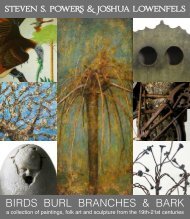HODGEPODGE
Some define "hodgepodge" as a confused mixture. Ignore that and go with the "a heterogeneous (or diverse) mixture." As one is exposed to more art and is receptive to expanding beyond one's preconceived notions or a tight focus, ones aesthetic evolves and lets art from one period or genre overlap with another—either in complement or contrast. Over the last twenty-plus years, my primary focus on early treen has expanded to where it is hard to see the connections between a-to-z. However, if one looks at a-to-b, b-to-c, c-to-d etcetera the connections and overlaps make sense—like an evolving an expanding Venn diagram. This is not to say there is not a focus or discipline—there very much is! The catalog herein has a diverse mix for sure—but everything was deliberately chosen and vetted for the integrity of vision, craftsmanship, surface, and condition. Enjoy!
Some define "hodgepodge" as a confused mixture. Ignore that and go with the "a heterogeneous (or diverse) mixture." As one is exposed to more art and is receptive to expanding beyond one's preconceived notions or a tight focus, ones aesthetic evolves and lets art from one period or genre overlap with another—either in complement or contrast.
Over the last twenty-plus years, my primary focus on early treen has expanded to where it is hard to see the connections between a-to-z. However, if one looks at a-to-b, b-to-c, c-to-d etcetera the connections and overlaps make sense—like an evolving an expanding Venn diagram.
This is not to say there is not a focus or discipline—there very much is! The catalog herein has a diverse mix for sure—but everything was deliberately chosen and vetted for the integrity of vision, craftsmanship, surface, and condition. Enjoy!
- No tags were found...
You also want an ePaper? Increase the reach of your titles
YUMPU automatically turns print PDFs into web optimized ePapers that Google loves.
STEVEN S. POWERS<br />
SUMMER 2019
STEVEN S. POWERS<br />
<strong>HODGEPODGE</strong><br />
hodgepodge noun<br />
hodge· podge | \ ˈhäj-ˌpäj \<br />
: a heterogeneous mixture : JUMBLE<br />
Some define "hodgepodge" as a confused mixture. Ignore that and<br />
go with the definition above "a heterogeneous (or diverse) mixture."<br />
As one is exposed to more art and is receptive to expanding<br />
beyond one's preconceived notions or a tight focus, ones aesthetic<br />
evolves and lets art from one period or genre overlap with<br />
another—either in complement or contrast.<br />
Over the last twenty-plus years, my primary focus on early treen<br />
has expanded to where it is hard to see the connections between<br />
a-to-z. However, if one looks at a-to-b, b-to-c, c-to-d etcetera the<br />
connections and overlaps make sense—like an evolving an<br />
expanding Venn diagram.<br />
This is not to say there is not a focus or discipline—there very<br />
much is! The catalog herein has a diverse mix for sure—but<br />
everything was deliberately chosen and vetted for the integrity of<br />
vision, craftsmanship, surface, and condition. Enjoy!<br />
Our next fair is:<br />
Antiques In Manchester | August 7-8, 2019<br />
Saint Anselm College, 100 St Anselm Dr., Manchester, NH 03102<br />
Show information: antiquesinmanchester.com<br />
W O R K S O F<br />
A R T<br />
& americana<br />
109 3rd Place #2, Brooklyn, NY 11231 | 718.625.1715 or 917.518.0809 | stevenspowers.com | member: ADA
Mischief Cats (detail)<br />
William Fellini ( -1965)<br />
Oil on canvas<br />
Circa: 1957<br />
Size: 27" (h) x 33" (w)
Southern Folk Art Limestone Carving of a Kissing Couple<br />
Kentucky (found)<br />
Circa: 1930-40<br />
Size: 8” x 8” x 9” (h)<br />
A dynamic carving of a nude male and female embraced in a<br />
kiss with the man’s hand on her upper thigh. She is not<br />
resisting, but her slight push may be a signal to slow it down<br />
a bit.<br />
Carvings as such in limestone are quite rare in that this small<br />
sculpture packs a lot of life into the stone. The work is carved<br />
in-the-round, and the figures have remarkable tension<br />
between them.<br />
It was found in a river 65 years plus ago in Prestonsburg,<br />
Floyd County, Kentucky.
The Snake Handler<br />
Oil on canvas<br />
Circa: 1930<br />
Size: 39”(w) x 69” (h)<br />
Provenance: Larry Dumont Collection; Marna Anderson,<br />
Frederick Hughes.<br />
Large and engaging painting of an African-American<br />
woman wearing a grass skirt handling three snakes in tall<br />
grass.<br />
A related painting of a “Fat Woman,” by the same hand is<br />
in a private collection. Though they are on stretched canvas<br />
and not painted like other carnival banners, they were<br />
likely part of a sideshow.
The Key To My Fantasy<br />
Pen & Ink on canvas board<br />
Circa: 1960-70<br />
Size: 16”(w) x 20” (h)<br />
This is a remarkable<br />
illustration by an as of yet<br />
unknown artist. The<br />
adeptly rendered nude<br />
figure and intricate design<br />
are masterfully worked and<br />
executed.<br />
Atypically, the substrate is<br />
canvas board (not paper or<br />
bristol board). The artist<br />
must have used a steel pen<br />
versus a mechanical<br />
rapidograph-type pen as<br />
the tips would have broken<br />
over and over.
This small masterwork by Materson recalls a day when Materson as a young<br />
teenager skipped school and played strip poker with a couple of older girls. The<br />
event was exciting, but not in the way that he had imagined. His figure lay in the<br />
scene like Christ with outstretched arms and a loincloth (tighty-whities).<br />
From The American Visionary Art Museum, "Born March 15, 1954 in Milford,<br />
Connecticut, Raymond Materson grew up in the Midwest. He earned a G.E.D. and<br />
attended Thomas Jefferson College as a drama and philosophy major, but was<br />
plagued by a serious drug problem. To support his habit, he committed a string of<br />
robberies with a shoplifted toy gun, was eventually arrested and sentenced to 15<br />
years in a state penitentiary in Connecticut. To keep himself sane Ray taught himself<br />
to embroider, using unraveled socks for thread and a sewing needle secured<br />
from a prison guard. He stitched miniature tapestries depicting life outside prison<br />
walls and sold his works to other inmates for cigarettes. Most of Materson's miniature<br />
embroideries include approximately 1,200 stitches per square inch and<br />
measure less than 2.5 x 3 inches.<br />
Since his release from prison in 1995, Ray has worked as a teacher, counselor,<br />
caseworker, program director, design consultant and speaker. With the help of his<br />
former wife Melanie, he published his autobiography, "Sins and Needles: A Story<br />
of Spiritual Mending." In 2003, he became the first artist to ever receive the Robert<br />
Wood Johnson Foundation's Innovators Combating Substance Abuse Award.<br />
Materson's work has been featured in numerous exhibitions at The American<br />
Museum of Folk Art in New York City, The American Visionary Art Museum in<br />
Baltimore, MD, The Center for Contemporary Art in Seattle, WA, The Boston<br />
Metropolitan Museum of Art, and The New Museum of Contemporary Art in New<br />
York City to name just a few."<br />
Provenance: Peter Brams Collection<br />
Illustrated & Discussed in: Sins & Needles, p.27
Public School Girls<br />
Ray Materson (1954 –)<br />
Unraveled socks<br />
Circa: 1994<br />
Size: 2 1/4" (h) x 2 3/4" (w) (sight)<br />
12" (h) x 14" (w) (framed)
Induction Center<br />
Thomas King Baker (1911 - 1972)<br />
Watercolor, charcoal, and calendar scrap on craft paper<br />
Size: 13 1/4"(h) x 9" (w)<br />
Exhibited: Albrecht-Kemper Museum of Art, MO, 1997<br />
Illustrated and discussed in: Oh For Pity’s Sake, We’ve Already Seen<br />
This Opera: The Art of Thomas King Baker; p. 37<br />
Thomas King Baker was an insurance underwriter by day, self-taught,<br />
basement artist by night. He and his wife, Mila Hoover, were<br />
middle-class socialites and enjoyed the opera, galleries, museums and<br />
a vibrant nightlife. King was friendly with local artists and was a<br />
collector. Among friends and family, his art-making was a poorly kept<br />
secret—they knew of his passion but were unaware of the extent of<br />
King’s breadth and body of work. King never exhibited while he was<br />
alive.<br />
King died from the effects of alcoholism in 1972.<br />
In 1991, Thomas McCormick, an art dealer, stumbled upon a few<br />
interesting paintings that he could not immediately identify. After<br />
some detective work, McCormick figured out that the works were by<br />
Baker. McCormick contacted Baker’s wife Mila, who was still alive and<br />
cataloged a large cache of works that Mila had kept together.<br />
King’s paintings, illustrations, and sketchbooks were exhibited at the<br />
Albrecht-Kemper Museum in 1997.
In 2007, the bulk of King’s estate was donated to Intuit: The Center<br />
for Intuitive and Outsider Art in Chicago.<br />
The two works herein illustrate King’s use of scrap materials and his<br />
gifted use of line and color. Like one of the works herein, King<br />
produced several works with calendar fragments. King was not<br />
ignorant of art history and contemporary art and the use of block<br />
numbers on, “Induction Center,” is likely a nod to Jasper Johns.<br />
Edward, Edward<br />
Thomas King Baker (1911 - 1972)<br />
Oil on shirt cardboard on craft paper<br />
Size: 12" (h) x 9" (w)<br />
Exhibited: Albrecht-Kemper Museum of Art, MO, 1997<br />
Illustrated and discussed in: Oh For Pity’s Sake, We’ve Already Seen<br />
This Opera: The Art of Thomas King Baker; p. 58
Study of a Male Nude &<br />
Young Highlander with<br />
Raised Arm<br />
John Kane (1860–1934)<br />
Circa: 1930<br />
Pencil on note paper<br />
Size: 8 1/2" x 5 1/2"<br />
Provenance: Galerie St.<br />
Etienne<br />
A rare John Kane double-sided pencil sketch. Kane is regarded as one of the masters of s<br />
artists.<br />
On the above or recto, note how Kane makes room for the hands to complete the sketch—<br />
room while drawing the figure's arms, so he placed them to the lower left. Above the han<br />
19thC English painters that he must have been studying.<br />
The verso illustrates a young boy in a Highlander outfit (Kane would use this figure in a<br />
paintings). The writing on this side lists the colors of the rainbow (Roy G. Biv).<br />
References: The Highland boy relates to figures in the following; Highland Hollow, Scotc<br />
Kennywood and Scotch Day, Kennywood (Arkus 68, 71 and 73).
lf-taught American<br />
he ran out of<br />
ds, Kane lists 18thfew<br />
finished<br />
h Day at<br />
verso
Nine Hands Cane with Shorebird and Dog<br />
Georgia (attributed)<br />
Circa: 1880<br />
Size: 35" (h)<br />
Provenance: Southern collection<br />
Literature: for a cane by the same hand<br />
see, Carved & Whittled Sculpture:<br />
American Folk Art Walking Sticks,<br />
Selections from the Pamela and Tim Hill<br />
Collection, page 98.<br />
A fascinating and mysterious carving with<br />
nine hands around the stick interspersed<br />
with carpentry tools and lizards. The top<br />
has a conjoined shorebird feeding its<br />
young and a dog’s head.<br />
Though the meaning is not known—the<br />
tools and hands make me think of<br />
“helping hands.” Or from a different<br />
perspective, the religious act of “laying<br />
on of hands.”
[from Wikipedia] "Miroslav Tichý was a photographer who from the 1960s until<br />
1985 took thousands of surreptitious pictures of women in his hometown of Kyjov<br />
in the Czech Republic using homemade cameras constructed of cardboard tubes,<br />
tin cans and other at-hand materials. Most of his subjects were unaware that they<br />
were being photographed. A few struck beauty-pageant poses when they sighted<br />
Tichý, perhaps not realizing that the parody of a camera he carried was real."<br />
In the 2000s a friend convinced Tichý that his work should be shown and<br />
organized an exhibit of his photography for the 2004 Biennial of Contemporary<br />
Art in Seville, Spain. Since then Tichý’s work has been recognized worldwide and<br />
has had major retrospectives at the Kunsthaus in Zurich in 2005, the Pompidou<br />
Centre in 2008, and the International Center of Photography, New York in 2010.<br />
His work is now part of most major institutional and private collections.
Untitled [Woman in a White Tank-Top]<br />
Miroslav Tichý (1926-2011)<br />
Unique gelatin silver print on Tichý mat<br />
Circa: 1960-1980 (n.d.)<br />
Size: 5" (w) x 6 3/4" (h) (sight)
Untitled [Woman Turned Right]<br />
Miroslav Tichý (1926-2011)<br />
Monotype etching<br />
Circa: 1970s (n.d.)<br />
Size: 6 1/2" (w) x 10" (h) (sight)<br />
Untitled [Woman with Apple]<br />
Miroslav Tichý (1926-2011)<br />
Monotype etching<br />
Circa: 1970s (n.d.)<br />
Size: 11 3/4" (w) x 16 1/2" (h) (sight)
Ange Boaretto (1920-??)<br />
France<br />
Circa: 1950s-60s<br />
Size: 43" x 8" (sight) / 48" x 12" (framed)<br />
Three large one piece, six paneled erotic<br />
paintings by self-taught artist Boaretto. Ange<br />
Boaretto was a master shoemaker in Southern<br />
France and self-taught painter.<br />
Although he had some recognition during his<br />
lifetime and a small exhibit at the Centre<br />
Georges Pompidou in 1979, entitled ‘Le Bible<br />
du Bottier’ (The Boot-makers Bible), he has<br />
mostly been forgotten.
Wall Street<br />
Vestie Davis<br />
Oil on Canvas<br />
Dated: 1959<br />
Size: 16” (w) x 20” (h)<br />
An early Davis—unusual for its placid depiction of a<br />
bustling area. Though you wouldn’t think it, the Wall<br />
Street area can be this quiet and deserted on an early<br />
Saturday or Sunday morning.
Second Avenue Barbershop<br />
Professor Arthur Cucino<br />
Oil on wood panel<br />
Circa: 1920s<br />
Size: 10 5/8" x 10 5/8"<br />
Provenance: The Meryl & Jay Weiss Collection, 2007; Don &<br />
Faye Walters Collection, 1986<br />
One cannot help but think of Edward Hopper’s, Early Sunday<br />
Morning, from a similar time. Though signed and stamped on<br />
the back, no records of Professor Arthur Cucino (or Cugino)<br />
have been found.<br />
From the May 31, 1896 edition of the New York Times, “Little<br />
Italy in New-York:”<br />
They are laborers; toilers in all grades of manual work; they are<br />
artisans, they are junkman, and here, too, dwell the rag pickers. ...<br />
There is a monster colony of Italians who might be termed the commercial<br />
or shop keeping community of the Latins. Here are all sorts<br />
of stores, pensions, groceries, fruit emporiums, tailors, shoemakers,<br />
wine merchants, importers, musical instrument makers.
Oblivious To Danger<br />
Oil on canvas<br />
Circa: 1930<br />
Size: 31 1/2" (w) x 29 1/2" (h)<br />
Provenance: Patty Gagarin, Private New York<br />
Collection; Private California Collection.<br />
Amusing allegorical folk art painting of a man fishing<br />
on a river or lake with a bear coming up behind him, a<br />
thunderstorm with sharp lightning, a fish out of the<br />
creel, a 'No Trespassing / Private Property' sign, a spilt<br />
bottle, and a sinking boat...but there is a rainbow on<br />
the horizon! I am not a fisherman, but I guess the<br />
message here is, "I'd Rather Be Fishing."
Folk Art Fetish Figure<br />
Wood, wheat paste/sawdust glue<br />
composite, paint, pitch<br />
Circa: 1900<br />
Size: 5 5/8" (h) x 1 1/2" (w)<br />
I regard this small figure as one of the<br />
most mysterious and striking figural<br />
carvings that I have ever seen.<br />
The body is carved from hardwood,<br />
and the rest of the female figure has<br />
applied composite features, including<br />
her face, breasts, belly button, and<br />
pubic area. The composite material<br />
appears to be made from a wheat<br />
paste mixed with glue and sawdust.<br />
The result of the applied facial<br />
“mask” looks like transplanted skin.<br />
The lips of her face and vagina have<br />
traces of applied dark red paint.<br />
The whole is finished with a natural<br />
tree pitch varnish.<br />
One can only speculate why this doll<br />
was carved. I have never seen a<br />
similar, but believe it to be more<br />
fetish in nature versus a simple play<br />
doll.
A Sailor’s Love Token<br />
New York State<br />
Ash Burl<br />
Circa: 1840-1860<br />
Size: 9 1/2" (w) x 5 3/4 (d) x 4 1/2" (h)<br />
A masterpiece of design and craftsmanship. Large lift top box<br />
with a deep relief-carved heart and (anthropomorphic) anchor<br />
composition.<br />
Carved from one block of ash burl. A tour-de-force of carving<br />
and execution.
Folk Art Hand Pipe<br />
New York State<br />
Ash Burl<br />
Circa: 1840-1860<br />
Size: 4 3/4" (l) x 3 1/2 (h)<br />
I’ve seen a few hand pipes<br />
over the years—and this is<br />
hands down (pun<br />
intended) the very best!<br />
Not only for the choice<br />
burl specimen or the rich<br />
patina, but also for the<br />
first-rate modeling and<br />
carving of the hand.<br />
Measuring a little less than<br />
life-size (so you can cup it<br />
in your hand), the fingers<br />
are well defined, and the<br />
thumb lifts to reveal a tin<br />
lined bowl a tin heart.<br />
Best of kind!
DR. SAMUEL JOHNSON’S SNUFFBOX<br />
Dr. Samuel Johnson (1709-1784) is "arguably the most distinguished man of letters in English history." His,<br />
Dictionary of the English Language, of 1755 is considered one of the great triumphs of lexicography. In 1764,<br />
Johnson and Sir Joshua Reynolds (painter) founded, The Club, which met every week at Turk's Head Inn,<br />
London to eat, drink, snuff, and smoke while discussing literature, politics and intellectual themes of the day.<br />
Other noted friends of Johnson's were, Oliver Goldsmith, (writer), David Garrick (actor), Giuseppe Baretti<br />
(lexicographer), Edmund Burke (statesman), and James Boswell (biographer, writer).<br />
The silver mounted box is carved in the form of a leather-gloved hand issuing a "fare la fica" gesture. La fica<br />
(Italian meaning "the fig"), is an ancient phallic hand gesture whereas the thumb is placed between the fore<br />
and middle fingers and shown to ward off the evil eye. It later became a more course gesture offered as<br />
contempt of another. Relating to tobacco culture of the 18thC, John Knox wrote, "any stranger who cannot<br />
take a pinch [of snuff], or give one, is looked upon with an evil eye."<br />
The carving and overall sculpture of the hand has a remarkable sensitivity—as we do not see a lifeless<br />
pillowed glove; we see a gloved hand! We hear the squeaky crunch of the leather as the fist clenches, and the<br />
fingers gain position!<br />
The etched inscription, "Dr. Samuel Johnson, The Lexicographer, 1770, From a Friend" begs the question,<br />
"who is the friend?" From the 17th to late 19th centuries snuffboxes were routinely given as gifts for<br />
friendship, respect or service. Though research did not a definitive answer, one name kept rising to the top—<br />
Giuseppe Baretti!<br />
Giuseppe Baretti (1719-1789) was an Italian writer, literary critic, and lexicographer who came to London in<br />
1751 and befriended Dr. Johnson. In the fall of 1769, Baretti was assaulted and accosted by a woman in the<br />
streets of Haymarket. Instinctively he pushed back at her. She screamed, and three-man attacked Baretti. In<br />
self-defense, he lashed out at them with a pocket knife and stabbed one man in the chest. Baretti was arrested<br />
and tried for murder. Johnson came<br />
to his defense as a character witness,<br />
and Baretti was acquitted.<br />
Arguably the "friend" is Giuseppe<br />
Baretti. He was a friend of Johnson's<br />
and a fellow lexicographer. He was<br />
an Italian living in London and<br />
culturally familiar with the "fare la<br />
fica" gesture. And the date is<br />
consistent with his legal troubles and<br />
someone who would want to thank<br />
and gift something special to<br />
Johnson for his friendship and legal<br />
support.
Dr. Samuel Johnson’s Snuffbox in the form of a Gloved Hand<br />
Dated: 1770 / Size: 4"(h)
Mischief Cats<br />
William Fellini ( -1965)<br />
Oil on canvas<br />
Circa: 1957<br />
Size: 27" (h) x 33" (w)<br />
William Fellini was a self-taught painter<br />
who worked as a house painter and day<br />
laborer in New York City. In his spare<br />
time, he would often buy used canvases<br />
and paint on the clean side (this<br />
painting has a half-finished figure by<br />
another hand on the other side).<br />
Though little is known about Fellini<br />
except for a few anecdotes, he produced<br />
a decent body of work from the late<br />
30s-60s.<br />
His paintings often have a quiet surreal<br />
quality or an element of surprise or<br />
humor to them. He used his marketable<br />
skill as a decorative painter and often<br />
incorporated faux marble tabletops as a<br />
foundation for his inventive still-lifes.<br />
Writing for the New York Times, Vivian<br />
Raynor reviewed the Schoelkopf<br />
Gallery’s December 1978 exhibit,<br />
(continued on next page)...
“Emile Branchard and William Fellini:<br />
Two 20th Century American Primitive<br />
Painters.” She wrote of Fellini, “His<br />
work is remarkable for its range of<br />
mood.... Many of the pictures include<br />
animals, sometimes to their detriment,<br />
as in the stately and minutely-painted<br />
flowers that are so upstaged by a<br />
demented kitten appearing over the far<br />
edge of the table.”<br />
The American Folk Art Museum has<br />
two works by Fellini in their collection.<br />
Bibliography: American Folk Art of<br />
the Twentieth Century, Johnson &<br />
Ketchum.<br />
Twentieth-Century American Folk Art<br />
and Artists, Hemphill & Weissman.<br />
Swan Lake<br />
William Fellini ( -1965)<br />
Oil on canvas<br />
Circa: 1960<br />
Size: 27" (h) x 35" (w)
Gas Station Beauty Queen<br />
Enamel paint on masonite<br />
Circa: 1960<br />
Size: 72" (h) x 24" (w)
Photo of Joseph Garlock,<br />
circa 1944, in front of his<br />
store, Bloomfiled, NJ<br />
Joseph Garlock<br />
immigrated from Russia<br />
to New York in 1904.<br />
After a bunch of odd<br />
jobs, Garlock and his<br />
wife settled in<br />
Bloomfield, NJ as the<br />
owners of a small fruits<br />
and vegetable store. In<br />
1948 he retired, and at<br />
sixty-four years, he<br />
found himself itching<br />
for something creative<br />
to do with his time.<br />
For the next several years, Garlock painted<br />
and sculpted somewhat compulsively. He<br />
painted at home and a while visiting his<br />
daughter Rose at her cabin in Woodstock, NY.<br />
Garlock's subjects ranged widely family<br />
portraits, local landscapes, pop culture, and<br />
religious ceremonies. He was inspired by<br />
images he saw in Life and Look magazines<br />
and created paintings based on photographs<br />
from these references.<br />
In his late 70s, Garlock developed palsy and<br />
sadly had to give up his brushes. He died in<br />
1980 at the age of 96.<br />
Joseph Garlock (18<br />
Oil on canva<br />
C<br />
27 3/4" (h) x 17<br />
The roadway here i<br />
the original sect<br />
Garden State Parkw<br />
began in Union C<br />
next door to Esse<br />
(where<br />
Note, how Garlock r<br />
the horizon as i<br />
wraps around
84-1980)<br />
Parkway<br />
s on glass<br />
irca: 1950<br />
5/8" (w)<br />
s possibly<br />
ion of the<br />
ay which<br />
ounty NJ,<br />
x County<br />
he lived).<br />
ounds off<br />
f the road<br />
the earth.
92.5%<br />
In the mid-1990s a cache of Garlock's work<br />
was found in a woodshed at his recently<br />
deceased daughters Woodstock property.<br />
James Cox, a local gallery owner, was called<br />
and immediately recognized the importance<br />
of the find and catalogued the work.<br />
Since then Garlock’s has been widely<br />
exhibited and collected.<br />
Exhibitions: "Joseph Garlock Paintings and<br />
Sculpture," The Cecille R. Hunt Gallery,<br />
Webster University, St. Louis, MO, 2003.<br />
"Old World, New Country: The Art of Joseph<br />
Garlock," The Center for Intuitive and<br />
Outsider Art, Chicago, IL, 2005.
Joseph Garlock (1884-1980)<br />
Woman with Roses<br />
Oil on canvas<br />
Circa: 1958<br />
Size: 23 1/2" (h) x 27 5/8" (w) sight<br />
Possibly a portrait or a tribute to his daughter Rose, who<br />
encouraged him to retire from his grocery store and paint. Rose<br />
had a cabin in Woodstock, NY—where this cache of works was<br />
discovered.
Woodlands Miniature Bowl & Ladle<br />
Circa: 1820-1840<br />
Size: bowl; 3 3/4" (l) x 2 1/2" (w) / ladle; 3" (oal) x 2 1/2" (w)<br />
Probably Ojibwa based on the shape of the bowl. The ladle is one of the<br />
smallest that I have ever seen. The oval bowl is thinly hewn and exhibits<br />
a beautiful patina.<br />
Due to the scale and limited wear, they were probably part of a medicine<br />
bundle. I am not sure if they started life together, as it is difficult to tell,<br />
but together they make a special pair.
Woodlands Fawn Effigy Ladle<br />
Maple<br />
Circa: 1820<br />
Size: 5 1/8" (oal)<br />
An exquisite ladle that I first owned about twenty years ago.<br />
The effigy is quiet and skillfully carved with an economy of form.<br />
The elegantly shaped handle has thinly channeled accents.<br />
Provenance: Brant Mackley; Steve Powers; Ned Jalbert; Peter Brams
Southwestern Dance Mask (Kachina)<br />
Hide, earth pigments, trade cloth<br />
Circa: 1900<br />
Size: 10" (h)) x 8" (w)<br />
Provenance: John Molloy; Peter Brams
(right) Folk Art [Woodlands] Carved Grizzly Bear<br />
Iowa (possibly Mesquakie / Meskwaki)<br />
Circa: 1875<br />
Size: 10 7/8" (l) x 6 5/8" (w) x 6" (h)<br />
A large one-piece carved sculpture of remarkable character and surface.<br />
The hefty bear is down on all fours with one hind leg coming through to<br />
the front.<br />
Based on my extensive<br />
experinece with both<br />
Woodlands carvings and<br />
"white man" folk art, I am<br />
inclined to believe that this<br />
sculpture was carved by a<br />
Mesquakie / Meskwaki<br />
native (who at the time had a<br />
presence in Iowa). The<br />
sensitivity of line, character,<br />
and wood surface are<br />
hallmarks of reference and<br />
both the creature and craft.<br />
(left) Bear & Birch<br />
Walter L. Steward (Maine)<br />
Circa: 1920<br />
Size: 11 1/2" (h)) x 8 1/2" (w)
Folk Art Carved Greater Yellowlegs<br />
Long Island, NY<br />
Circa: 1900<br />
Size: 12" (l) x 6" (h)<br />
Provenance: Stephen O’Brien Jr. Fine Arts, Peter Brams Collection<br />
Attributed to Nelson Verity (1854-1947) and related to birds from the<br />
Powell Hotel rig. Three piece laminated construction (body one piece with<br />
laminated wings).<br />
Folk Art Carved Lesser Yellowlegs<br />
Polpis, Nantucket, MA<br />
Circa: 1880<br />
Size: 9" (l) x 4 1/2" (h)<br />
A geometric carving with a baleen bill. Previously had a label which read:<br />
"Lesser Yellowlegs found under (illegible) barn at Polpis 1929."<br />
Old second coat of paint covers a few shot scars.<br />
Literature: Joel Barber, "Wildfowl Decoys," New York, NY, 1932, pp. 68,<br />
87, plates 1, 54.<br />
Provenance: Copley Fine Arts, Peter Brams Collection
Folk Art Carved Golden Plover<br />
Massachusetts<br />
Circa: 1900<br />
Size: 13 1/2" (l) x 3 3/4" (h)<br />
Provenance: Russ & Karen Goldberger, Peter Brams Collection<br />
Stylish original paint and shoe button eyes with original bill. Flaking on<br />
other side.<br />
Folk Art Carved Turned-Head Yellowlegs<br />
Lombard Jones<br />
Sandwich, MA<br />
Circa: 1916<br />
Size: 7" (l) x 5" (h) (not including driftwood base)<br />
With it's head sharply turned almost ninety degrees this decoy was made by<br />
Lombard Jones for his uncle, Dr. Lombard Jones. Influenced by the Chipman<br />
family's hollow turned-head shorebirds that were also gunned in Sandwich's<br />
Old Harbor. Jones is known to have made<br />
yellowlegs and several peeps.<br />
In very good condition with gunning wear, bill is old replacement.<br />
Provenance: Copley Fine Arts, Peter Brams Collection
A Rare Mechanical Black-Bellied Plover Decoy<br />
Boston, MA<br />
Circa: 1868<br />
Size: 11 3/4" (l) x 8" (w) x 5" (h)<br />
Provenance: Stephen O’Brien Jr. Fine Arts, Peter Brams Collection<br />
A Rare Mechanical Black-Bellied Plover Decoy by Nathaniel Wales<br />
& Snow, Boston, MA, circa: 1868. Based on the Wales patent of<br />
1868, the wings are fabricated from cardboard and canvas and a<br />
cord weaves through the wood carved body. Stamped “WALES &<br />
SNOW PATENT.”
Maine Duck Guide Sign<br />
Circa: 1900<br />
Size: 36" (l) x 17" (h)<br />
Here is a cool well weathered and worn sign. Constructed from the<br />
top of an old blanket chest (ghost marks from big strap hinges<br />
visible) and a duck decoy (cut in half), this sign served as a marker<br />
for an old duck hunting guide.<br />
Old losses as visible in the photo with a great crazed paint surface.
Folk Art Miniature Ducks<br />
Willie Ross (1878-1954)<br />
Chebeague Island, Maine<br />
Circa: 1900<br />
Sizes range from: 4 1/2" (l) to 2" (l)<br />
A rare set of miniatures, mostly mergansers, by<br />
known decoy carver, Willie Ross of Chebeague<br />
Island, Maine. Ross gifted the set to a family<br />
member before his death in 1954<br />
(documentation letter included).
Tyger Tyger, burning bright,<br />
In the forests of the night....<br />
Carved and Painted Folk Art Tiger Wall Box<br />
David Heber Kimball (1850-1927)<br />
Dated May 5, 1917<br />
Meadowville, Rich County, Utah.<br />
Size: 18" (h) x 15" (w) x 5" (d)<br />
The carvers father was Heber C. Kimball (1801-1868) who was a<br />
leader in the early Latter Day Saint movement. He served as one of<br />
the original twelve apostles in the early Church of the Latter Day<br />
Saints and as the first counselor to Brigham Young in the First<br />
Presidency of The Church of Jesus Christ of Latter-day Saints.
Dilmus Hall (1900-1987)<br />
Lamb<br />
Concrete, rebar, paint<br />
Circa: 1970’s<br />
Size: 18" (l) x 10" (w) x 13 1/4" (h)<br />
Provenance: Barbara Archer Gallery; Larry Dumont Collection<br />
As a child Hall would fashion small sculptures made from flour mixed<br />
with tree sap. Discouraged by his father, he didn’t pursue art until later<br />
in life.<br />
After serving in WWI as a stretcher bearer, he returned to Georgia and<br />
worked as a hotel bell captain, a sorority house busboy and then as a<br />
fabricator of concrete blocks for a construction company. It was here<br />
that Hall found himself again<br />
working with his hands.<br />
He began making concrete<br />
sculpture around his home. His<br />
sculpture combined a mix of<br />
Christianity with an African<br />
conjuring culture that empowered<br />
objects with protective powers.<br />
Later he would make little tableaus<br />
with wood and putty that recall the<br />
modeling technique he developed<br />
as a child.<br />
Still image from the documentary, The<br />
Mind's Eye, with Hall at his home, circa<br />
1987.
BUG KILLER<br />
Gorham, Maine<br />
Oil paint on tin<br />
Circa: 1890<br />
Size: 13 1/2" (w) x 38" (h)<br />
A graphically strong advertsing sign from Carswell The<br />
Druggist, Gorham, ME. Painted in a vibrant yellow and black<br />
with red shadowed letters on BUG KILLER and an orange on<br />
the huge bug (Maine Potato Beetle).
Physical Graffiti<br />
English School Desk<br />
Circa mid 1920s<br />
Size: 29" x 16"<br />
Most dates are from the mid 1920s with one errant “1943.”<br />
Some of the surnames are: Leitch; Robin; Hunter; Boyd; Somerville;<br />
Marshin; Bonnar; Black; Grant; Stephen; Conner; Baxter; Hately; Irvin;<br />
Lamont and Dunford.
"Perpitraight, Peerless, Perponderant"<br />
Melvin Way (1954-)<br />
Black ink on paper<br />
Circa: 2000<br />
Size: 5 1/2" (w) x 4" (h)<br />
The Outsider Artist Melvin Way suffers from schizophrenia,<br />
bi-polar disorder, and diabetes.<br />
Way has stated, “All my works have to go thru emissions,<br />
baptisms, and transmigrations before I release them into the<br />
stratosphere, I carry 500 drawings at a time in my raincoat, and<br />
they go thru rain sleet and snow, sometimes staying in my pocket<br />
for 6 months at a time.”<br />
Art critic Jerry Salz says of Way’s work, “[He is] a mystic<br />
visionary genius...one of the greatest living American artists.<br />
Melvin Way makes knotted diagrams of numbers, letters, lines,<br />
and arrows that look like alchemical equations.”
Three early drawings by<br />
Jonathan Borofsky from his<br />
number series.<br />
Provenance: Paula Cooper<br />
Gallery; Peter Brams Collection.<br />
(left) 2522585 / 1978 / 8 1/2"x 11" a<br />
strong early Borofsky ballpoint pen<br />
drawing.<br />
(above) 2481385 / 1976 / 4 3/4"x 4<br />
3/4" done with red, black and blue<br />
ballpoint pens on graph paper.<br />
(right) 2829924 / 1983 / 5"x 3" on<br />
"Phone with Paula and Parents" blue<br />
ballpoint pen on note paper.
Rare Redware Monkey Bank & Whistle<br />
Pennsylvania<br />
Circa: 1860<br />
Size: 5" (oah)<br />
Provenance: David Good, Peter Brams
Rare Redware Serpent & Figural Jug<br />
Leonard Kopp<br />
Lineboro, MD or Black Rock, PA<br />
Circa: 1860-1880<br />
Size: 7 3/4 (h)" x 8" (wide w/handle)<br />
Provenance: Kopp family by descent;<br />
Robert Girouard, Peter Brams<br />
Collection<br />
Signed on bottom in incised script “L.<br />
Kopp.”<br />
Kopp was a known production potter in<br />
the Maryland area and all his known<br />
pieces are stamped—this is the only<br />
known with freehand script signature<br />
and by far the finest example of his<br />
documented work.
A large screw-type nutrcr<br />
featuring an expressive m<br />
well defined features and<br />
mouth. His hair is finely<br />
shaped almost like a leaf<br />
handle is carved as a fish<br />
surface is first rate—a rea<br />
lovers piece.<br />
A tour-de-force of design<br />
execution. One of the mo<br />
intricate, complex and h<br />
carved coquilla boxes I h<br />
(left) Exceptional English<br />
Figural Nutcracker<br />
Boxwood (or fruitwood)<br />
Circa: 1720-1760<br />
Size: 11" (oal")<br />
(right top) French Folk Ar<br />
Snuffbox - Six Men & A D<br />
Circa: 1854<br />
Size: 3" x 2" x 1 1/2"<br />
An exceptional French co<br />
nut snuffbox. Masterfully<br />
with six men and a dog o<br />
top. The interior is signe<br />
maker and dated 1854.
een<br />
acker<br />
an with<br />
an open<br />
done—<br />
. The<br />
. The<br />
l treen<br />
t Treen<br />
og<br />
quilla<br />
carved<br />
n the<br />
d by the<br />
(below) Treen Alligator Nutcracker (Screwtype)<br />
French<br />
Circa 1830-40<br />
Size: 9 1/2” (l)<br />
The Leavenworth Nutcracker Museum has one that looks to be by<br />
the same hand.<br />
and<br />
st<br />
gh-relief<br />
ave seen.
Folk Art Religious Tableau, "The Sacred Family"<br />
Buffalo, New York<br />
Italian-American<br />
Circa: 1930<br />
Size: 16" x 13"<br />
Provenance: Tim Hill, David Wheatcroft, Peter Brams<br />
Illustrated: Folk Art Magazine, Winter 2003/2004, p. 15<br />
A complex folk art tableau of the Sacred Family; Mary,<br />
Joseph and the baby Jesus. Made out of crate wood, the<br />
carved and painted figures and elobotate platform were<br />
carved by an Italian-American in New York.
ANTI-SLAVERY MEETINGS!<br />
Salem, Ohio<br />
Circa: 1850<br />
Size: 10 1/2” (w) x 15 1/2” (h) (sight)<br />
Rare Abolitionist broadside. Excellent condition.<br />
Union with Freemen—No Union with Slaveholders.<br />
ANTI-SLAVERY MEETINGS!<br />
Anti-Slavery Meetings will be held in this place, to commence on<br />
at in the To be Addressed by Agents of the Western ANTI-<br />
SLAVERY SOCIETY.<br />
Three millions of your fellow beings are in chains—the Church<br />
and Government sustains the horrible system of oppression.<br />
Turn Out!<br />
AND LEARN YOUR DUTY TO YOURSELVES, THE SLAVE AND<br />
GOD.<br />
EMANCIPATION or DISSOLUTION, and a FREE NORTHERN<br />
REPUBLIC!<br />
HOMESTEAD PRINT, SALEM, OHIO.
Stop Lynching - Shame of America<br />
Rebel arts<br />
Circa: 1939<br />
Size: 22" (w) x 28" (h) (sight)<br />
Bold and graphically strong red silkscreened banner. Designed by<br />
Rebel Arts to be carried in May Day.<br />
Rebel Arts was a politically left arts collective formed in New<br />
York City that included, among others, Harry Herzog, Alex<br />
Haberstroch and Fairfield Porter.
It’s About Time!<br />
Circa: 1920<br />
Size: 27" x 29"<br />
An unusual and graphically strong American Folk Art<br />
hooked rug. It has a very contempory aesthetic and feels<br />
like a precursor of early Pop Artist Dorothy Grebenak.
Family Gathering At Our Texas Farm / graphite on paper / 1936 / 7 5/8" (h) x 11 3/4" (w)<br />
This unsigned, but dated group of folk art drawings, completed over a<br />
few weeks in July and August 1936, captures the quaint insight into<br />
the world of an unknown proudly Texan artist.<br />
They illustrates a family gathering, the interior, and exterior of a small<br />
home, church, school, farm life and a couple in a field of bluebonnets.<br />
The renderings are drafted with a good sense of composition,<br />
perspective, and handling of the graphite.
(top) My Sunday Texas Church / graphite on paper / 1936 / 7 1/2" (h) x 11 3/4" (w)<br />
(bottom) Our Texas Home / graphite on paper / 1936 / 7 5/8" (h) x 11 3/4" (w)
Rare British Sign Language (BSL) Copper Plate Printed Handkerchief<br />
Circa: mid 19th century<br />
Size: irregular and unmounted ~ 12" x 14"<br />
“How To Teach The Deaf and Dumb a Language....” I have not been able<br />
to locate another like (BSL) example.
Rare American Sign Language (ASL) Copper Plate Printed Handkerchief<br />
Circa: mid 19th century<br />
Size: irregular and unmounted ~ 12" x 14"<br />
“How To Teach The Deaf and Dumb a Language....” Have only located one<br />
other - in the Cotsen Children’s Library, Princeton University.
Provenance: Cavin-M<br />
Gallery; Ricco/Mare<br />
Gallery; Larry Dumo<br />
Collection<br />
The front is compos<br />
two families at hosp<br />
beds. The back, with<br />
large Hell Hound, is<br />
recent discovery fou<br />
while considering a<br />
mat board—now ref<br />
to show both sides.<br />
Sister Gertrude Mor<br />
(1900-1980)<br />
Untitled [Hospital Be<br />
with Hell Hound]<br />
Tempera, graphite o<br />
window shade<br />
Circa: 1965-1975 (n<br />
Size: 17" (w) x 17"
.d.)<br />
(h)<br />
gan<br />
ds<br />
n<br />
orris<br />
sca<br />
nt<br />
ed of<br />
ital<br />
a<br />
a<br />
nd<br />
new<br />
ramed
Eye Opener Liquor Bottle<br />
Circa: 1880<br />
Size: 11 1/4" (h)<br />
Who doesn’t love a rebus—even if its just a short one. Unusual<br />
stoneware bottle with a three dimensional and realistically glazed<br />
eye ball sticking out of one side with the word “opener” below it<br />
and a minstrel-like figure dancing on the other side.
Eight is Enough<br />
Iowa<br />
Concrete and polychrome<br />
Circa: 1920-1930<br />
Size: range from 4 1/4" (h) - 7 1/4" (h)<br />
Provenance: Larry Dumont<br />
Illustrated in, The Magazine Antiques, July/August 2019, p. 118<br />
A family of eight concrete dolls. Found as a group in Iowa,<br />
these “dolls” are unique and mysterious. Sensational surfaces.
A Group of Fine Gogottes (offered individually)<br />
Fontainbleu France<br />
Oligocene epoch (33.9 million to 23 million years old)<br />
Size: 22" (l) / 9 1/2" (h) / 9" (h) / 13" (h)
A gogotte is a millions years old naturally shaped mineral concretion formed of tiny<br />
quartz fragments held together by calcium carbonate. Principally found in<br />
Fontainebleau, France, these mother-nature made sculptures have inspired artists from<br />
Jean Arp, Henry Moore and Louise Bourgeois. Louis XIV favored them and the have been<br />
exhibited at Versailles since the late 17thC.
Unusual Set of Nine Scale<br />
Model Photographs<br />
Circa: 1915-25<br />
Size: 5" x 7" (each)<br />
Aside from the mayhem, I<br />
have not figured out fully<br />
what is going on within this<br />
set of images, but a lot of<br />
work went into creating the<br />
sets and subjects.<br />
I am not exactly sure of the<br />
scale of the original sets, but<br />
I am figuring something like<br />
an elaborate train set.
Willian (Bill) Anhang was born in Poland in 1931 and immigrated to<br />
Canada with his family in 1939 to escape the Nazi occupation. As a<br />
young man, Anhang trained as an engineer and worked in<br />
telecommunications. In 1975, A Guru spoke to him and said he must<br />
become an artist. Since then Anhang’s has devoted himself to bring “new<br />
light to the planet.”<br />
The enamel works seen here are among Anhang’s earliest works. They are<br />
small-scale abstractions—many with suggestions of another world or<br />
grand universe. They have undeniable energy. Well composed, not too<br />
busy and with intense, saturated color.<br />
Anhang later incorporated real light into his work—paintings illuminated<br />
by hundreds if not thousands of blinking and programmed LEDs and<br />
fiber optics.<br />
These early enamel works may be<br />
seen as his acoustic period, like Dylan<br />
before Newport, and then he plugged<br />
in, went electric, and never really<br />
went back.<br />
Anhang’s work was recently exhibited<br />
at American Folk Art Museum in the<br />
exhibit, When the Curtain Never<br />
Comes Down, 2015.<br />
The Canadian Broadcasting<br />
Corporation (CBC) produced a 20<br />
minute documentary on Anhang,<br />
Billsville, and is available on Youtube.<br />
Photo of William (Bill) Anhang in his studio.
William Anhang (1931-)<br />
Untitled [Winged Boots]<br />
Enamel on copper<br />
Circa: 1979<br />
Size: 6 3/4" (w) x 4" (h)<br />
William Anhang (1931-)<br />
Untitled<br />
[Character on Blue]<br />
Enamel on copper<br />
Circa: 1979<br />
Size: 7 1/8" x 6 1/2" (h)
STEVEN S. POWERS<br />
W O R K S O F<br />
A R T<br />
& americana<br />
109 3rd Place #2, Brooklyn, NY 11231 | 718.625.1715 or 917.518.0809<br />
stevenspowers.com | member: ADA


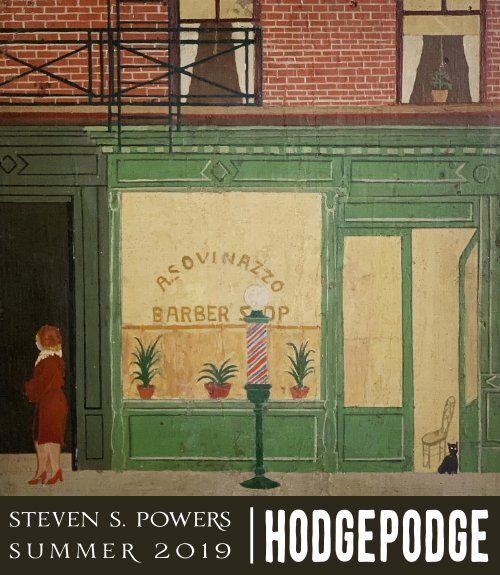

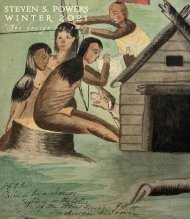
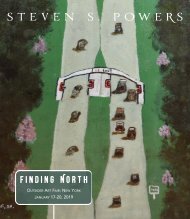

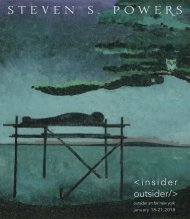
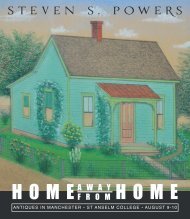
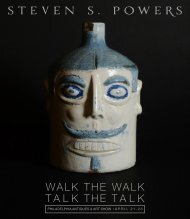
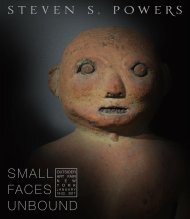
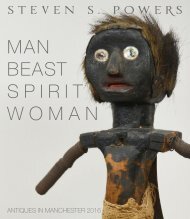
![NEEDLE • KNIFE • TORCH [&] BRUSH](https://img.yumpu.com/55309753/1/190x219/needle-o-knife-o-torch-brush.jpg?quality=85)
